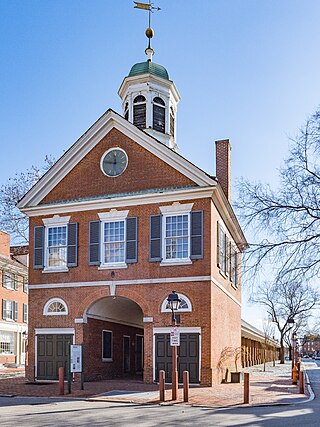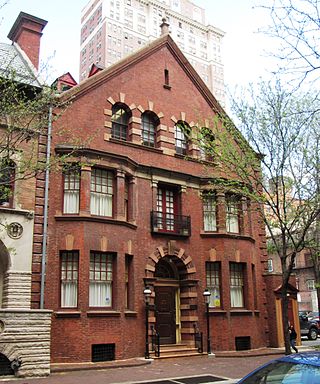
The Philadelphia History Museum was a public history museum located in Center City, Philadelphia from 1938 until 2018. From 1938 until 2010, the museum was known as the Atwater Kent Museum. The museum occupied architect John Haviland's landmark Greek Revival structure built in 1824–1826 for the Franklin Institute. The Museum operated as a city agency as part of Philadelphia's Department of Recreation. The building was listed on the National Register of Historic Places on August 1, 1979.
Witold Rybczynski is a Canadian American architect, professor and writer. He is currently the Martin and Margy Meyerson Professor Emeritus of Urbanism at the University of Pennsylvania.

Paul Philippe Cret was a French-born Philadelphian architect and industrial designer. For more than thirty years, he taught at a design studio in the Department of Architecture at the University of Pennsylvania.

Laurel Hill Cemetery, also called Laurel Hill East to distinguish it from the affiliated West Laurel Hill Cemetery in Bala Cynwyd, is a historic rural cemetery in the East Falls neighborhood of Philadelphia. Founded in 1836, it was the second major rural cemetery in the United States after Mount Auburn Cemetery in Boston, Massachusetts.

The Cathedral Basilica of Saints Peter and Paul, head church of the Roman Catholic Archdiocese of Philadelphia, is located at 18th Street and the Benjamin Franklin Parkway, on the east side of Logan Square in Philadelphia. It was built between 1846 and 1864, and was designed by Napoleon LeBrun, from original plans by the Reverend Mariano Muller and the Reverend John B. Tornatore, with the dome and Palladian facade, designed by John Notman, added after 1850. The interior was largely decorated by Constantino Brumidi.

The Woodlands is a National Historic Landmark District on the west bank of the Schuylkill River in Philadelphia. It includes a Federal-style mansion, a matching carriage house and stable, and a garden landscape that in 1840 was transformed into a Victorian rural cemetery with an arboretum of over 1,000 trees. More than 30,000 people are buried at the cemetery. Among the tombstones at Woodlands cemetery is the tombstone of Dr Thomas W. Evans, which at 150 feet (46 m), is both the tallest gravestone in the United States and the tallest obelisk gravestone in the world.

The University of Pennsylvania Campus Historic District is a historic district on the campus of the University of Pennsylvania, in Philadelphia, Pennsylvania, USA. The university relocated from Center City to West Philadelphia in the 1870s, and its oldest buildings date from that period. The Historic District was added to the National Register of Historic Places on December 28, 1978. Selected properties have been recorded by the Historic American Buildings Survey, as indicated in the table below.

John Notman was a Scottish-born American architect and landscape architect based in Philadelphia. He designed buildings, cemeteries, churches and country estates in the Mid-Atlantic region of the United States and helped popularize Italianate architecture in the United States.

The Penn Mutual Life Insurance Company, commonly referred to as Penn Mutual, was founded in Philadelphia, Pennsylvania, in 1847. It was the seventh mutual life insurance company chartered in the United States. As of 2019, it had 3,140 employees, $3.7 billion in revenue, and $36.7 billion in assets.

Theophilus Parsons Chandler Jr. was an American architect of the late 19th and early 20th centuries. He spent his career at Philadelphia, and is best remembered for his churches and country houses. He founded the Department of Architecture at the University of Pennsylvania (1890), and served as its first head.
Charles Emil Peterson is an American preserver. He is known for professionalizing historic preservation in the United States. He is referred to as the "founding father" of the professional advocation of historic preservation, the "godfather of preservation," and an "extraordinary preservationist" who made important contributions to the knowledge of early American building practices, helped create the profession of the preservation architect, and passionately advocated for the retention and restoration of the American built heritage. According to Jacques Dalibard, a professor at McGill University School of Architecture, "with James Marston Fitch, I cannot think of two people who had more influence on historic preservation in North America."

The Redwood Library and Athenaeum is a subscription library, museum, rare book repository and research center founded in 1747, and located at 50 Bellevue Avenue in Newport, Rhode Island. The building, designed by Peter Harrison and completed in March 1750, was the first purposely built library in the United States, and the oldest neo-Classical building in the country. It has been in continuous use since its opening.

St. Peter's Episcopal Church in Pittsburgh, Pennsylvania, was an early example of the archaeological phase of Gothic Revival architecture, designed by the Philadelphia architect John Notman. It was originally built in 1851 at the corner of Grant and Diamond streets as a chapel of ease for Trinity Episcopal Church in the Diocese of Pittsburgh. The church and its site were purchased by Henry Clay Frick. The building itself was donated back to the congregation. It was dismantled, the stones numbered, and taken up Forbes Avenue in horsedrawn wagons to the corner of Forbes and Craft avenues, where it was reconstructed in 1901. It received a plaque from the Pittsburgh History and Landmarks Foundation. The church was deconsecrated in September 1989, and the building was demolished.

Andalusia, also known as the Nicholas Biddle Estate, is a historic mansion and estate located on the Delaware River, just northeast of Philadelphia, in Bensalem Township, Bucks County, Pennsylvania. The community surrounding it, Andalusia, takes its name from the 225-acre estate.

New Market, as it was originally known, and later also known as Head HouseMarket and Second Street Market, is an historic street market which is located on South 2nd Street between Pine and Lombard Streets in the Society Hill neighborhood of Philadelphia, Pennsylvania. With a history dating to 1745, it is one of the oldest surviving market buildings of its type in the nation.

St. Thomas Episcopal Church is a historic church located at the southeast corner of Main and Focer streets in the borough of Glassboro in Gloucester County, New Jersey. It was built in 1846 and documented by the Historic American Buildings Survey (HABS) in 1937, with an addendum in 1984. It added to the National Register of Historic Places on March 3, 1975, for its significance in architecture.

The Ebenezer Maxwell House, operated today as the Ebenezer Maxwell Mansion, is an historic house located in the West Germantown neighborhood of Philadelphia, Pennsylvania.

The Dr. Joseph Leidy House is a historic residence located at 1319 Locust Street between S. 13th and S. Juniper Streets in the Washington Square West neighborhood of Philadelphia, Pennsylvania. It was built in 1893 and 1894 and was designed in the Georgian style by architect Wilson Eyre to be the home of Joseph Leidy, Jr., the nephew of Joseph Leidy (1823–1891), a noted American paleontologist. The house is next door to the Clarence B. Moore House, which was designed by Eyre in 1890.

The Hatfield House is an historic house which is located in Fairmount Park in Philadelphia, Pennsylvania.

Allen Evans was an American architect and partner in the Philadelphia firm of Furness & Evans. His best known work may be the Merion Cricket Club.


























